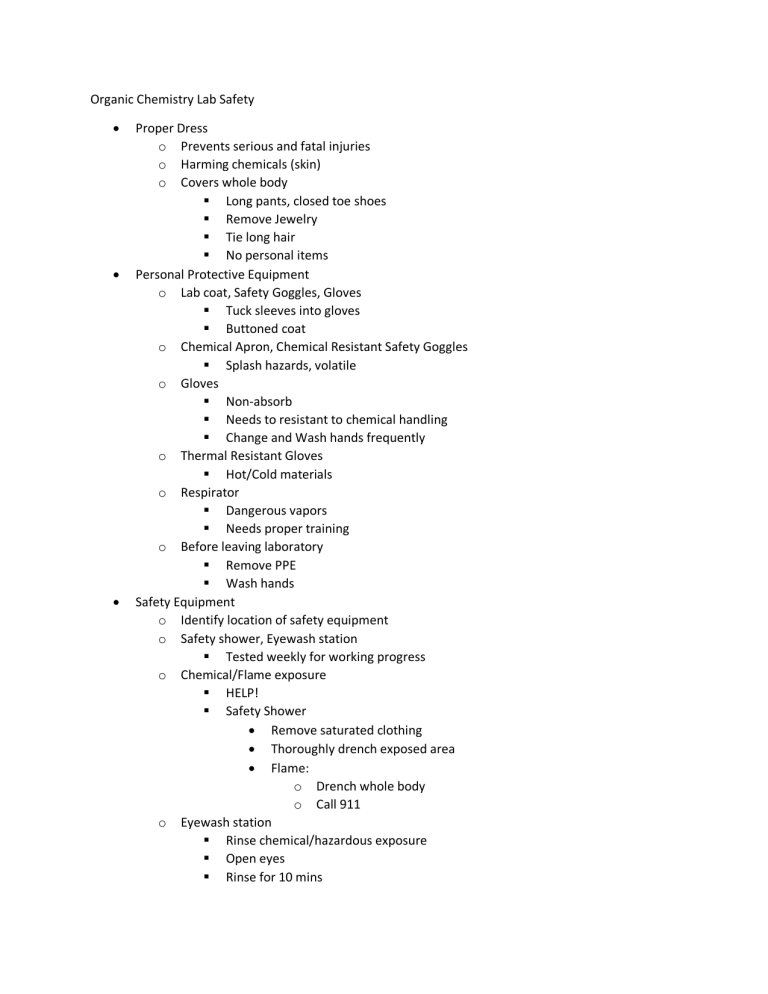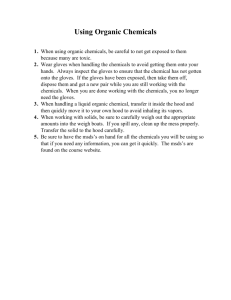
Organic Chemistry Lab Safety Proper Dress o Prevents serious and fatal injuries o Harming chemicals (skin) o Covers whole body Long pants, closed toe shoes Remove Jewelry Tie long hair No personal items Personal Protective Equipment o Lab coat, Safety Goggles, Gloves Tuck sleeves into gloves Buttoned coat o Chemical Apron, Chemical Resistant Safety Goggles Splash hazards, volatile o Gloves Non-absorb Needs to resistant to chemical handling Change and Wash hands frequently o Thermal Resistant Gloves Hot/Cold materials o Respirator Dangerous vapors Needs proper training o Before leaving laboratory Remove PPE Wash hands Safety Equipment o Identify location of safety equipment o Safety shower, Eyewash station Tested weekly for working progress o Chemical/Flame exposure HELP! Safety Shower Remove saturated clothing Thoroughly drench exposed area Flame: o Drench whole body o Call 911 o Eyewash station Rinse chemical/hazardous exposure Open eyes Rinse for 10 mins o Fire extinguisher Fire types Class A (Combustion): Wood, paper, cloth o Extinguish by water/extinguisher Class B: Organic solvents, flammable liquids Class C: Electrical o B+C: Chemical Foam Extinguishers Water (worse): spread, Class D (Combustible metals) o Fire Blanket Small flames (floors, workbenches) Clothing Lay down Wrap Do not wrap (standing) fire rises o First aid kit Bandages, Antiseptic (Minor injuries) o Evacuation route o Chemical Fume Hood Ventilated closed work area Protects from toxic vapors Turn on exhaust fan Make sure hood is venting properly Do not store chemical under hood Clean and remove materials when finished Sash Opening window (raised/lowered) o Opened to 8-16 inches Behavior o Follow written standard operating procedures: No food, beverage, chewing gum, makeup May lead to contamination of skin, ingestion of chemicals, contamination of experiment Never work alone o Good housekeeping Dispose debris on the floor (may cause fall) Do not place chemical bottles on floor (even temporarily) Spilled chemical: Check safety data sheet (proper response) Routine spill: Clean immediately (wet floor sign) Clean, organized workbench: Store unneeded items Only have needed materials Do not place materials near edge of workbench Broken glass: o Cut may cause hazardous chemical into bloodstream o Use broom and dustpan o Dispose properly Wash and dry glassware Return reagents Clean workbench (ethanol, isopropyl) Chemical Hazards o Safety Data Sheet (STS) (MSDS) Chemical properties, hazards, safety precautions Review before working with chemicals GHS (Globally Harmonized System of Classification and Labelling of Chemicals) Provides international standard format for safety data sheets (16 sections) o Section 1: Identification Name, description, manufacturer’s contact info. o Section 2: Hazard Identification Warnings, safety symbols o Section 3: Composition Ingredients o Section 4: First-Aid Required treatment to exposure o Section 5: Fire-fighting o Section 6: Accidental Release Containment and cleanup of spills o Section 7: Handling and storage o Section 8: Exposure controls and Personal protection Exposure limits and recommendations for PPE o Section 9: Physical and Chemical properties Appearance, odor, pH, flash point, solubility, evaporation rate o Section 10: Stability and Reactivity How to avoid hazardous reactions o Section 11: Toxicological Likely routes of symptoms Short and long term effects o Non-mandatory sections o Section 12: Ecological o Section 13: Disposal o Section 14: Transport o Section 15: Regulatory o Section 16: Other Info Date of STS preparation (and revision) New GHS format Labelled with: o Product name o Signal word o Physical, health and environmental hazard statements o Precautionary statements o Pictograms (represent hazard) o First aid instructions o Supplier’s contact info Before starting experiments: o Determine possible risks o Wear proper PPE o Be aware of protective measures/emergency responses (chemicals) Diluting acid/bases: o Add acids/bases to water (solvent) o Do not add solvent into acids/bases (violent reaction; may cause burns) Never remove chemical from the lab o Use break resistance secondary container to transport chemicals to other lab spaces o Chemicals must be handled safely: Avoid skin, eye, inhalation exposure Eye protection o Safety glasses w/ side shield (Some protection) o Splash goggles (Protection from splashing hazardous chemicals) (Z87.1 (code for American National Standard Institute) o Prescription glasses + Full face shield/Safety glasses/Splash Goggles Skin protection o Lab coat + gloves (some protection) o Full length chemical resistant apron (Splash hazard protection) o Full arm length rubber gloves (Highly corrosive chemical) Inhalation exposure o Never smell chemicals o Always work under fume hood o Keep containers closed tight when not in use o Chemical spillage Evacuate immediately, notify authorities Large spills can cause huge vapors Flammable Chemical Techniques o Always know flammability and explosive potential o Keep away from ignition sources (bunsen burners, hot plates) o Store chemicals in a grounded/dedicated storage cabinet o Properly dispose of chemicals according to federal, state, local and institutional requirements o Use chemical resistant plastics/metal containers for waste disposure o Solvent should not be evaporated under fume hood for disposure Any cleaning materials used to clean chemical are considered hazardous o Must be disposed properly

